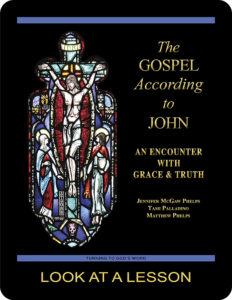God so loved the world
 The Gospel According to John 3:16 (NABRE) is possibly the most frequently quoted summation of God’s love for humanity: “For God so loved the world that he gave his only Son, so that everyone who believes in him might not perish but might have eternal life.”
The Gospel According to John 3:16 (NABRE) is possibly the most frequently quoted summation of God’s love for humanity: “For God so loved the world that he gave his only Son, so that everyone who believes in him might not perish but might have eternal life.”
For good reason this reading has become synonymous with the Gospel, the core essence of the Christian message. It also shows an interesting aspect of the element of Christian love. Much has been said about the verb translated here as “loved”, ἀγαπάω (agapao), and one common definition of it based on passages such as this is: “God’s selfless love for humanity.” The Gospel According to John suggests the need for a somewhat broader definition. The same word, ἀγαπάω (agapao), comes up again in the Gospel According to John 3:19 (NABRE): “… the light came into the world, but people preferred darkness to light, because their works were evil,” and is translated as “preferred.” The contrast here suggests a root meaning closer to “giving oneself to something else.” This view shows the same level of attachment of the more common definition but leaves room for the possibility the object of that giving isn’t always worthy.
The reason this distinction is so important is that it’s easy as Christians to buy the premise that all we have to do to be good is to love. This passage suggests the opposite is true, that we have to be good in order to love. From there, the question of how one becomes good presents itself, and this passage suggests a way to proceed. The starting point and the ongoing demand of the Christian life is faith, absolute trust in God in a way that draws us into union with him. From there, God will purify our loving along with everything else about us. In short, we don’t make ourselves good. That’s beyond our human capacity. God does. This Lent, we’re called to remove the barriers to that process and to allow God to work within us.
you also may like our study of the Gospel According to John
 The Gospel According to John: An Encounter with Grace & Truth, a 25-lesson Catholic Bible study with an imprimatur, examines the Fourth Gospel’s view of Jesus Christ as the Son of God, with special emphasis on the institution of the sacraments of the Church as the means by which Christians are purified and made holy. This recently revised study includes maps and additional commentary, and takes a closer look at the way in which Jesus relates to individual men and women. Click on the book’s cover to view a sample lesson.
The Gospel According to John: An Encounter with Grace & Truth, a 25-lesson Catholic Bible study with an imprimatur, examines the Fourth Gospel’s view of Jesus Christ as the Son of God, with special emphasis on the institution of the sacraments of the Church as the means by which Christians are purified and made holy. This recently revised study includes maps and additional commentary, and takes a closer look at the way in which Jesus relates to individual men and women. Click on the book’s cover to view a sample lesson.
 Click on the picture of the statue of Moses with horns (above) to learn more about Lost in Translation. A new entry is archived each Monday. Contact us to receive Lost in Translation by email every week. You may use any of the contact links on our website to ask Matthew a question.
Click on the picture of the statue of Moses with horns (above) to learn more about Lost in Translation. A new entry is archived each Monday. Contact us to receive Lost in Translation by email every week. You may use any of the contact links on our website to ask Matthew a question.
